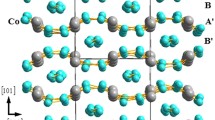Summary
Ferroelectricity has been observed almost exclusively in chalcogenides, in particular in oxides. Except for a few IV–VI compounds (SnTe, etc.) all ferroelectrics are ternary or more complex compounds. The best-investigated ternary ferroelectrics are perovskites, whose electronic and dynamical properties have been studied in detail. Generally, the ferroelectric phase transition is based on a critical cancellation of repulsive and attractive forces (Slater). The residual force governing the phase transition and related properties is the fourth-order polarizability of the chalcogen ions or a corresponding cluster polarizability of anionic groups. The thermodynamic and dynamic properties can be described quite well in a self-consistent phonon approximation, while nonequilibrium metastable excitations, such as photoferroelectric phenomena, require a more exact nonlinear treatment of the crystal polarizability.
Riassunto
La ferroelettricità è stata osservata quasi esclusivamente nei calcogenuri, e particolarmente negli ossidi. Salvo pochi composti IV–VI (SnTe, ecc.) i ferroelettrici sono ternari o composti ancora piú complessi. I ferroelettrici ternari piú conosciuti sono le perovskiti, le cui proprietà elettroniche e dinamiche sono state studiate in dettaglio. In generale la transizione di fase ferroelettrica è basata sulla cancellazione critica delle forze attrattive e repulsive (Slater). La forza residua che governa la transizione di fase e proprietà correlate è la polarizzabilità del quarto ordine degli ioni calcogeni o la polarizzabilità complessiva dei gruppi anionici. Le proprietà dinamiche e termodinamiche possono essere ben descritte nell'approssimazione dei fononi autoconsistenti, mentre le eccitazioni metastabili di non equilibrio, come i fenomeni foto-ferroelettrici, richiedono una piú rigorosa trattazione non lineare della polarizzabilità cristallina.
Резюме
Наблюдается ферроэлектричество в халькогенидах, в частности, в окислах. За исключением некоторых IV-VI соединений (SnTe и др.), все ферроэлектрики являются трехкомпонентными или более сложными соединениями. Наиболее исследованными трехкомпонентными ферроэлектриками явяются перовскиты, электронные и динамические свойства которых изучены подробно. Ферроэлектрический фазовый переход основан на критической взаимной компенсации отталкивающей и притягивающей сил. Остаточная сила, определяющая фазовый переход и родственные свойства, представляет поляризуемость четвертого порядка халякогенидных ионов или соответствующую поляризуемость кластеров анионных групп. Термодинамические и динамические свойства могут быть хорошо описаны в самосоггасованном фононном приближении, тогда как неравновесные метастабильные возбуждения, такие как фото-ферроэлектрические явления, требуют более точного нелинейного рассмотрения поляризуемости кристалла.
Similar content being viewed by others
Literatur
Landolt-Börnstein:Tables of Ferro- and Antiferroelectrics (Heidelberg, 1975).
M. E. Lines andA. M. Glass:Principles and Applications of Ferroelectrics and Related Materials (Oxford, 1977).
J. C. Slater:Phys. Rev.,78, 478 (1950).
H. Fröhlich:Theory of Dielectrics (Oxford, 1958).
W. Cochran:Adv. Phys.,9, 387 (1960).
P. W. Anderson:Fizika Dielektrikov (Moscow, 1960).
J. Yamashita andM. Kojima:J. Phys. Soc. Jpn.,7, 261 (1952).
R. Migoni, H. Bilz andD. Bäuerle:Phys. Rev. Lett.,37, 1155 (1976).
I. B. Bersuker andB. G. Vekhter:Fiz. Tverd. Tela,9, 2652 (1967).
N. N. Kristoffel andP. I. Konsin:Izv. Akad. Nauk Est. SSR, Ser. Fiz. Math.,16, 429 (1967).
H. Kawamura:Proceedings of the Conference on Narrow Gap Semiconductors, Warsaw (New York, N. Y., 1977).
A. Bussmann, H. Bilz, R. Roenspiess andK. H. Schwarz:Ferroelectrics,25, 343 (1980).
A. Bussmann-Holder, G. Benedek, H. Bilz andB. Mokross:J. Phys. (Paris),12, C6–409 (1981).
K. A. Müller andH. Burkhard:Phys. Rev. B,19, 3593 (1979).
D. Rytz, U. T. Höchli andH. Bilz:Phys. Rev. B,22, 359 (1980).
M. Balkanski, M. K. Teng, M. Massot andH. Bilz:Ferroelectrics,25, 737 (1980).
M. H. Grimdsditch:Solid State Commun.,25, 389 (1978).
H. Bilz, A. Bussmann, G. Benedek, H. Büttner andD. Strauch:Ferroelectrics,25, 339 (1980).
G. Benedek, H. Bilz andA. Bussmann-Holder:Z. Phys., to be published.
A. Bussmann-Holder, H. Bilz, D. Bäuerle andD. Wagner:Z. Phys. B,41, 353 (1981).
M. Löhnert, G. Kaindl, G. Wortmann andD. Salomon:Phys. Rev. Lett.,47 194 (1981).
V. M. Fridkin:Photo-Ferroelectrics (Berlin, 1979).
H. Büttner andH. Bilz: inRecent Developments in Condensed Matter Physics, Vol. 1, edited byJ. Devreese (New York, N. Y., 1981), p. 49.
H. Fröhlich:Int. J. Quantum Chem.,2, 641 (1968).
H. Bilz, H. Büttner andH. Fröhlich:Z. Naturforsch. Teil B,36, 208 (1981).
Author information
Authors and Affiliations
Rights and permissions
About this article
Cite this article
Bilz, H., Bussmann-Holder, A. & Benedek, G. Ferroelectricity in ternary compounds. Il Nuovo Cimento D 2, 1957–1963 (1983). https://doi.org/10.1007/BF02457894
Received:
Issue Date:
DOI: https://doi.org/10.1007/BF02457894




